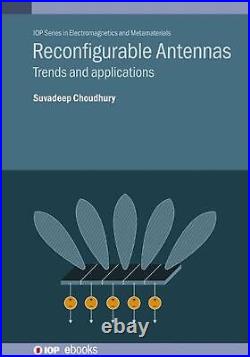Reconfigurable Antennas Trends and applications by Suvadeep Choudhury Hardcover



The book aims at covering the basic designs and methodology of reconfigurable antennas, to the recent developments in the field of reconfigurable antennas, metasurface-based reconfigurable designs, reflectarray and transmitarray based structures, and liquid-based reconfigurable antennas. This book is primarily targeted to the young engineers and researchers who are planning to start their early careers in the field of reconfigurable antenna designs; and also at the experienced scientists, who are planning to keep themselves updated on the state-of-the- art designs in reconfigurable antennas. This book would serve as a single platform wherein the discussion would range from the basic design methodology to advanced designs, and current work scenarios. Provide an elaborate and lucid introduction on reconfigurable antennas; its historical perspective and various applications. Discuss fundamentals on designing reconfigurable antennas, practical challenges, and various performance attributes. Revisit the design and practical realization of various families of reconfigurable antennas. Highlight various recent designs of mm-wave antennas: Ka-, Q- and V-band. Design methodology to Metasurface-based reconfigurable designs, reflectarray and transmitarray based structures, and liquid-based reconfigurable antennas. Suvadeep Choudhury received his M. Tech from The University of Burdwan where he was awarded the University Gold medal in 2013. Tech, he was associated with the Microwave Tubes Research and Development Center, DRDO, Bengaluru. Subsequently, he earned his Ph. Degree in the Department of Electronics and Electrical Communication Engg. From Indian Institute of Technology Kharagpur. Thereafter, he worked as Technical Lead in the R&D wing of HCL Tech. And as a Post-Doctoral Research Associate at IIT Kharagpur, jointly with SAC, ISRO, before joining The LNMIIT as an Assistant Professor. Currently, he is a Post-Doctoral Research Fellow at the Department of Information Engineering, University of Pisa, ITALY on-lien from The LNMIIT Jaipur, INDIA. Suvadeep expertise in design and development of low profile and high gain antennas. He is currently a Senior Member of URSI, Member of IEEE, and Life Member of IETE. ForewordPrefaceAcknowledgmentsAuthor biography1 Introduction 1.1 Introduction to reconfigurable antennas 1.2 Fundamentals of reconfigurable antennas 1.3 Classifications of reconfigurable antennas 1.4 Active devices and their role in achieving reconfigurability in antennas 1.5 Frequency-reconfigurable antennas 1.6 Polarization-reconfigurable antennas 1.7 Pattern-reconfigurable antennas References2 Frequency-reconfigurable antennas 2.1 Introduction 2.2 Frequency reconfigurability by tunable devices 2.3 Frequency reconfigurability based on smart materials 2.4 Frequency reconfigurability based on mechanical movement 2.5 Summary References3 Polarization-reconfigurable antennas 3.1 Introduction 3.2 Solid-state-based polarization-reconfigurable antennas 3.3 Microelectromechanical system radio frequency switches for polarization reconfigurability 3.4 Varactor diodes for polarization reconfigurability 3.5 Polarization reconfigurability using metasurfaces 3.6 Other methods to achieve polarization reconfigurability 3.7 Summary References4 Pattern-reconfigurable antennas 4.1 Introduction 4.2 Reconfigurable Yagi-Uda array 4.2.1 Yagi-Uda array 4.2.2 Reconfigurable microstrip-based Yagi-Uda array 4.3 Reconfigurable parasitic arrays 4.3.1 Monopole array 4.3.2 Dipole array 4.3.3 Microstrip patch array 4.3.4 Patch-based phased array 4.3.5 Collinear dipole array 4.3.6 Some other forms of pattern reconfigurability 4.4 Pattern reconfigurability by electronically changing the feed network 4.5 Mechanically-controlled pattern reconfigurability 4.6 Summary References5 Hybrid reconfigurable antennas 5.1 Introduction 5.2 Frequency and bandwidth reconfigurability 5.3 Frequency and radiation pattern reconfigurability 5.4 Frequency and polarization reconfigurability 5.5 Radiation pattern and polarization reconfigurability 5.6 Frequency, radiation pattern, and polarization reconfigurability 5.7 Summary References6 Mechanically-reconfigurable transmitarray and reflectarray antennas 6.1 Introduction 6.2 Element movement 6.2.1 Reconfigurable resonant elements 6.2.2 Reconfigurable non-resonant elements 6.3 Array movement 6.3.1 Risley prism-based antennas 6.3.2 Rotatable transmitarray and reflectarray antennas 6.3.3 Tiltable ground-plane reflectarray antennas 6.4 Feed movement 6.4.1 Feed movement on fully illuminated apertures 6.4.2 Feed movement on partially illuminated apertures 6.5 Hybrid mechanical movement 6.6 Summary References7 Reconfigurable leaky-wave antennas 7.1 Introduction to leaky-wave antennas 7.2 Operating principle 7.3 Reconfigurable leaky-wave antennas 7.4 Metamaterial-based reconfigurable leaky-wave antennas 7.4.1 Introduction to metamaterials 7.4.2 Metamaterial-based reconfigurable leaky-wave antennas 7.5 Substrate integrated waveguide-based reconfigurable leaky-wave antenna 7.5.1 Introduction to substrate integrated waveguides 7.5.2 Substrate integrated waveguide-based leaky-wave antenna 7.6 Microstrip-based reconfigurable leaky-wave antennas 7.6.1 Introduction to microstrip antennas 7.6.2 Feeding methods 7.6.3 Microstrip-reconfigurable leaky-wave antenna 7.7 Summary References8 Reconfigurable metasurfaces and liquid-based reconfigurable antennas8.1 Introduction 8.2 Homogeneous reconfigurable metasurfaces 8.2.1 Electronically-tunable metasurfaces 8.2.2 Mechanically-tunable metasurfaces 8.2.3 Optically-tunable metasurfaces 8.2.4 Thermally-tunable metasurfaces 8.3 Inhomogeneous reconfigurable metasurfaces 8.4 Liquid-based reconfigurable antennas 8.4.1 Introduction 8.4.2 Conductive fluids 8.4.3 Substrate materials 8.4.4 Reconfigurable liquid metal-based antennas 8.4.5 Frequency-reconfigurable antennas 8.4.6 Polarization reconfigurable antennas 8.4.7 Pattern-reconfigurable antennas 8.4.8 Liquid metal-based antenna applications 8.5 Summary ReferencesAppendix A: Understanding scattering parametersAppendix B: Radiation and its use in wireless communication systems. Publisher Institute of Physics Publishing. Imprint Institute of Physics Publishing. Place of Publication Bristol. Country of Publication United Kingdom. Illustrations With Figures in Colour and Black and White. AU Release Date 2023-11-28. NZ Release Date 2023-11-28. Subtitle Trends and applications. Audience Professional & Vocational. UK Release Date 2023-09-14. We’ve got this. At The Nile, if you’re looking for it, we’ve got it.

Related News

Reconfigurable Active and Passive Planar Antennas for Wireless Communication Sys
Reconfigurable Active and Passive Planar Antennas for Wireless Communication Systems. By Shiban Kishen Koul, RajeshRead More

Reconfigurable Antennas Trends and applications by Suvadeep Choudhury Hardcover
The book aims at covering the basic designs and methodology of reconfigurable antennas, to theRead More


Comments are Closed